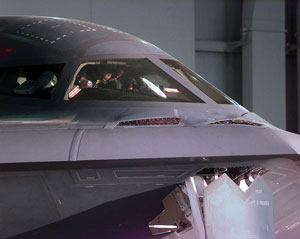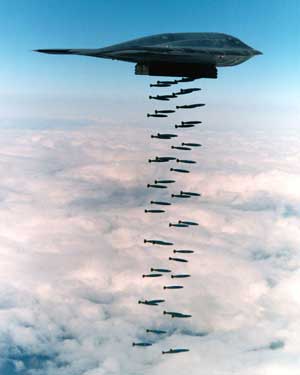 The
B-2 Spirit is a multi-role bomber capable of delivering
both conventional and nuclear munitions. The
B-2 Spirit is a multi-role bomber capable of delivering
both conventional and nuclear munitions.
Along with the B-52 and B-1B, the B-2
provides the penetrating flexibility and effectiveness
inherent in manned bombers. Its low-observable, or
"stealth," characteristics give it the unique ability to
penetrate an enemy's most sophisticated defenses and
threaten its most valued, and heavily defended, targets.
Its capability to penetrate air defenses and threaten
effective retaliation provide an effective deterrent and
combat force well into the 21st century.
The blending of low-observable
technologies with high aerodynamic efficiency and large
payload gives the B-2 important advantages over existing
bombers. Its low-observability provides it greater freedom
of action at high altitudes, thus increasing its range and
a better field of view for the aircraft's sensors. Its
unrefueled range is approximately 6,000 nautical miles
(9,600 kilometers).
The B-2's low observability is derived
from a combination of reduced infrared, acoustic,
electromagnetic, visual and radar signatures. These
signatures make it difficult for the sophisticated
defensive systems to detect, track and engage the B-2.
Many aspects of the low-observability process remain
classified; however, the B-2's composite materials,
special coatings and flying-wing design all contribute to
its "stealthiness."
The B-2 has a crew of two pilots, an
aircraft commander in the left seat and mission commander
in the right, compared to the B-1B's crew of four and the
B-52's crew of five.
The B-2 is intended to deliver gravity
nuclear and conventional weapons, including
precision-guided standoff weapons. An interim,
precision-guided bomb capability called Global Positioning
System (GPS) Aided Targeting System/GPS Aided Munition
(GATS/GAM) is being tested and evaluated. Future
configurations are planned for the B-2 to be capable of
carrying and delivering the Joint Direct Attack Munition (JDAM)
and Joint Air-to-Surface Standoff Missile.
B-2s, in a conventional role, staging
from Whiteman AFB, MO; Diego Garcia; and Guam can cover
the entire world with just one refueling. Six B-2s could
execute an operation similar to the 1986 Libya raid but
launch from the continental U.S. rather than Europe with a
much smaller, more lethal, and more survivable force.
 |
| What is amazing
about this photo is not the number of MK-82 bombs
dropping out of it, but the fact that only about
half of the 80 total MK-82 500-lb. bombs that it can
carry are visible in this photo. |
Background
The B-2 development program was
initiated in 1981, and the Air Force was granted approval
in 1987 to begin procurement of 132 operational B-2
aircraft, principally for strategic bombing missions. With
the demise of the Soviet Union, the emphasis of B-2
development was changed to conventional operations and the
number was reduced to 20 operational aircraft, plus 1 test
aircraft that was not planned to be upgraded to an
operational configuration. Production of these aircraft
has been concurrent with development and testing.
The first B-2 was publicly displayed on
Nov. 22, 1988, when it was rolled out of its hangar at Air
Force Plant 42, Palmdale, Calif. Its first flight was July
17, 1989. The B-2 Combined Test Force, Air Force Flight
Test Center, Edwards Air Force Base, Calif., is
responsible for flight testing the engineering,
manufacturing and development aircraft as they are
produced. Three of the six developmental aircraft
delivered at Edwards are continuing flight testing.
Whiteman AFB, Mo., is the B-2's only
operational base. The first aircraft, Spirit of Missouri,
was delivered Dec. 17, 1993. Depot maintenance
responsibility for the B-2 is performed by Air Force
contractor support and is managed at the Oklahoma City Air
Logistics Center at Tinker AFB, Okla.
The prime contractor, responsible for
overall system design and integration, is Northrop
Grumman's Military Aircraft Systems Division. Boeing
Military Airplanes Co., Hughes Radar Systems Group and
General Electric Aircraft Engine Group are key members of
the aircraft contractor team. Another major contractor,
responsible for aircrew training devices (weapon system
trainer and mission trainer) is Hughes Training Inc. (HTI)
- Link Division, formerly known as C.A.E. - Link Flight
Simulation Corp. Northrop Grumman and its major
subcontractor HTI, are responsible for developing and
integrating all aircrew and maintenance training programs.
The Air Force is accepting delivery of
production B-2s in three configuration blocks--blocks 10,
20, and 30. Initial delivery will be 6 test aircraft, 10
aircraft in the block 10 configuration, 3 in the block 20
configuration, and 2 in the block 30 configuration.
Block 10
configured aircraft provide limited combat capability
with no capability to launch conventional guided
weapons. The Block 10 model carries only Mk-84
2,000-pound conventional bombs or gravity nuclear
weapons. B-2s in this configuration are located at
Whiteman Air Force Base and are used primarily for
training.
Block 20
configured aircraft have an interim capability to launch
nuclear and conventional munitions, including the GAM
guided munition. The Block 20 has been tested with the
Mk-84, 2,000-pound, general-purpose bombs and the
CBU-87/B Combined Effects Munition cluster bombs
(low-altitude, full-bay release).
Block 30
configured aircraft are fully capable and meet the
essential employment capabilities defined by the Air
Force. The first fully configured Block 30 aircraft,
AV-20 Spirit of PENNSYLVANIA, was delivered to the Air
Force on 07 August 1997. Compared to the Block 20, the
Block 30s have almost double the radar modes along with
enhanced terrain-following capability and the ability to
deliver additional weapons, including the Joint Direct
Attack Munition and the Joint Stand Off Weapon. Other
features include incorporation of configuration changes
needed to make B-2s conform to the approved radar
signature; replacement of the aft decks; installation of
remaining defensive avionics functions; and installation
of a contrail management system.
All block 10, 20, and test aircraft are
to eventually be modified to the objective block 30
configuration. This modification process began in July
1995 and is scheduled to be completed in June 2000.
The B-2 fleet has 16 combat-coded
aircraft as of FY2003.
 |